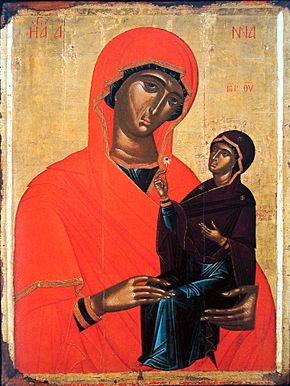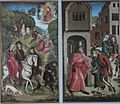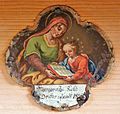Saint Anne facts for kids
Quick facts for kids SaintAnne |
|
|---|---|

|
|
| Mother of the Virgin, Maternal Heroine, Woman of Amram | |
| Venerated in | Roman Catholic Church Eastern Catholic Churches Eastern Orthodox Church Oriental Orthodox Church Anglican Communion Lutheranism Islam Afro-American religion |
| Canonized | Pre-Congregation |
| Feast | 26 July (Roman Catholic), 09 September (Eastern Orthodox) 09 December (Orthodox) The Conception by St. Anne of the Most Holy Theotokos |
| Attributes | Book; door; with Mary, Jesus or Joachim; woman dressed in red or green |
| Patronage | Brittany, Canada, Detroit, Taguig, Hagonoy, Bulacan, Kurunegalle Catholic Diocese, Sri Lanka; Fasnia (Tenerife); Mainar; unmarried women; carpenters; child care providers; childless people; children; equestrians; grandparents; homemakers/housewives; lace makers; lost articles; miners; mothers; moving house; old-clothes dealers; poverty; pregnancy; seamstresses; stablemen; sterility; teachers |
Saint Anne is a very important figure in Christian and Islamic traditions. She is known as the mother of Mary and the grandmother of Jesus. Her name, and the name of her husband Joachim, are not found in the main Christian Bible. Instead, we learn about them from older writings and traditions, like the Gospel of James, which was written around 150 AD.
In the Islamic faith, Anne (called Hannah) is also highly respected. She is seen as a very spiritual woman and the mother of Mary. The Quran mentions her as "the wife of Imran" but does not use her name.
Contents
Stories and Traditions
Many stories about Saint Anne are similar to the biblical story of Hannah, who was also childless before having her son, Samuel. In Eastern Christian traditions, Anne is called an "Ancestors of God." Two important celebrations, the Nativity of Mary (Mary's birth) and the Presentation of Mary (Mary being presented at the temple), are big holidays in the Eastern Orthodox Church.
Anne in Islam
In Islam, Hannah (Anne) was childless for a long time. One day, she saw a bird feeding its young. This made her wish for a child of her own. She prayed, and soon she became pregnant. Her husband, Imran, passed away before their child was born. Hannah had hoped for a son and had promised to dedicate him to serving in the Second Temple.
However, Hannah gave birth to a daughter, whom she named Mary. Her words after Mary's birth show her deep faith. She understood that even though she wanted a son, this daughter was a special gift from God. The Quran describes her saying that God knew best what she had given birth to, and that a male is not like a female in this special case. God accepted Mary with great favor.
Early Christian Beliefs
The main Christian Bible does not mention Mary's mother. However, stories about Mary's family, childhood, and marriage to Joseph became popular very early in the Church's history. The most important source for these stories is the Gospel of James. This book was written in Greek around the middle of the second century AD.
For a long time, some people believed that Mary was conceived without original sin. This idea is called the Immaculate Conception. It means that God kept Mary's body and soul pure and sinless from the very beginning of her life. This belief was officially made a teaching in the Catholic Church in 1854 by Pope Pius IX. It is important to remember that the Immaculate Conception is about Mary's conception, not about Jesus's birth.
Honoring Saint Anne
People have honored Saint Anne for a very long time. In the Eastern Church, people started honoring her around 550 AD. An early church was built in her honor in Constantinople. In the Western Church, the first picture showing her being honored is an 8th-century painting in a church in Rome.
Many places around the world have special shrines dedicated to Saint Anne. Two famous ones are Sainte-Anne-d'Auray in France and Basilica of Sainte-Anne-de-Beaupré in Canada. Many visitors come to these shrines, especially on Saint Anne's Feast Day, which is July 26. In 1892, Pope Leo XIII even sent a special relic (a holy object) of Saint Anne to the church in Canada.
In the Maltese language, the Milky Way galaxy is called It-Triq ta' Sant'Anna, which means "The Way of St. Anne." In Russia, the Order of St Anna was a very important state award.
Feast Days
By the mid-600s, a special day to celebrate the conception of Mary by Saint Anne was observed. In the Greek Orthodox Church, this day is called "The Conception by St. Anne of the Most Holy Theotokos" and is celebrated on December 9. In the Roman Catholic Church, the Feast of Saints Anne and Joachim is celebrated on July 26.
Relics of Saint Anne
It is believed that relics of Saint Anne were brought from the Holy Land to Constantinople in 710 AD. During the 12th and 13th centuries, crusaders and pilgrims brought relics of Anne to many churches in Europe. These relics are still kept and honored in cathedrals and monasteries in places like Austria, Canada, Germany, Italy, and Greece.
Düren in Germany has been a main pilgrimage site for Saint Anne since 1506. This is because Pope Julius II decided that her relics should be kept there.
Who Saint Anne Helps
Saint Anne is considered a patron saint for many different groups of people and things.
- She is the patroness of unmarried women, housewives, and women who are pregnant or wish to become pregnant.
- She is also a patron of grandmothers, mothers, and teachers.
- Other groups she helps include horseback riders, carpenters, and miners. Miners honor her because Mary and Jesus are sometimes compared to precious metals like silver and gold. Anne's womb was seen as the source from which these "precious metals" were "mined."
- Saint Anne is also said to be a patron saint of sailors and a protector from storms.
Many cities and regions around the world have Saint Anne as their patron saint. These include Brittany in France, Quebec in Canada, Detroit in Michigan, and many places in the Philippines and Spain.
Saint Anne in Art
Saint Anne is often shown in religious art. Her emblem is a door, and she is frequently shown wearing red and green clothes, which represent love and life.
The Meeting at the Golden Gate
A common scene in art is "The Meeting at the Golden Gate." This shows Joachim and Anne meeting and embracing at the Golden Gate in Jerusalem. They have both been told by an angel that Anne is pregnant. This moment represents the conception of Mary.
Virgin and Child with Saint Anne
Another popular subject in art is the "Virgin and Child with Saint Anne." This shows Anne with her daughter Mary and the infant Jesus. Sometimes, Anne is shown teaching the Virgin Mary to read the Scriptures.
Saint Anne is not usually shown at the birth of Jesus. However, she is often seen with the infant Jesus in other scenes. It is believed that Anne passed away when Jesus was still young, as she is not shown with him as an adult. She is also sometimes shown as the head of the "Holy Kinship," which is the extended family of Jesus.
Gallery
-
Coptic, 8th century, National Museum in Warsaw
-
The Virgin and Child with Saint Anne in the Cathedral Museum of the Church of Santiago de Compostela
-
A French Virgin and Child with Saint Anne (15th-century) from Languedoc-Roussillon
-
The Holy Family with Saint Anne and Saint-Jeannet by El Greco (c. 1600), conserved in the Biblioteca Museu Víctor Balaguer
Images for kids
-
The instruction of Mary. Catholic parish church of St. Martin in the district of Dillingen (Bavaria).
-
The Education of the Virgin. Guido Reni (1640-1642)
-
The education of the Virgin, Eugène Delacroix (1842)
-
The Education of the Virgin Mary, Jean Jouvenet (1700)
See also
 In Spanish: Ana (madre de María) para niños
In Spanish: Ana (madre de María) para niños























